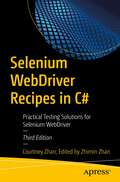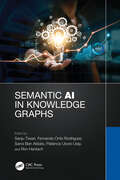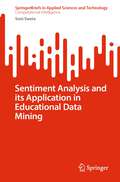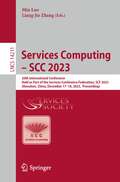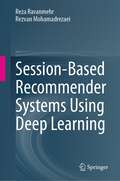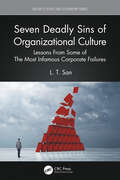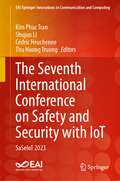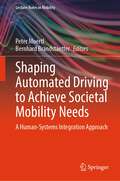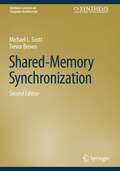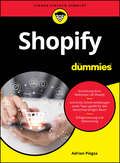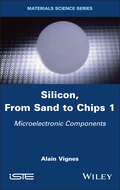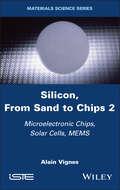- Table View
- List View
Selected Reflections in Language, Logic, and Information: ESSLLI 2019, ESSLLI 2020 and ESSLLI 2021 Student Sessions, Selected Papers (Lecture Notes in Computer Science #14354)
by Alexandra Pavlova Mina Young Pedersen Raffaella BernardiThe European Summer School in Logic, Language and Information (ESSLLI) is organized every year by the Association for Logic, Language and Information (FoLLI) in different sites around Europe. The papers cover vastly dierent topics, but each fall in the intersection of the three primary topics of ESSLLI: Logic, Language and Computation. The 13 papers presented in this volume have been selected among 81 submitted papers over the years 2019, 2020 and 2021. The ESSLLI Student Session is an excellent venue for students to present their work and receive valuable feedback from renowned experts in their respective fields. The Student Session accepts submissions for three different tracks: Language and Computation (LaCo), Logic and Computation (LoCo), and Logic and Language (LoLa).
Selenium WebDriver Recipes in C#: Practical Testing Solutions for Selenium WebDriver
by Courtney ZhanSolve your Selenium WebDriver problems with this quick guide to automated testing of web applications with Selenium WebDriver in C#. This third edition contains hundreds of solutions to real-world problems, with clear explanations and ready-to-run Selenium test scripts that you can use in your own projects. Updated to Selenium version 4, this revision includes Visual Studio Code set up, additional recipes, and new chapters on Selenium DevTools and continuous testing. You'll see how to use Selenium WebDriver for select lists, navigation, assertions, frames, file upload and pop-up dialogs. You'll also learn how to locate web elements and test functions for hyperlinks, buttons, TextFields and TextAreas, radio buttons, CheckBoxes, and more. What You'll Learn Debug test scripts and test data Work with Selenium Remote Control Server Manage and deal with browser profiles and capabilities Monitor tests for advanced user interactions and experiences (UX) Who This Book Is For Experienced .NET and C# Windows application programmers/developers.
Semantic AI in Knowledge Graphs
by Sanju Tiwari Fernando Ortíz-Rodriguez Sarra Ben Abbés Patience Usoro Usip Rim HantachRecent combinations of semantic technology and artificial intelligence (AI) present new techniques to build intelligent systems that identify more precise results. Semantic AI in Knowledge Graphs locates itself at the forefront of this novel development, uncovering the role of machine learning to extend the knowledge graphs by graph mapping or corpus-based ontology learning. Securing efficient results via the combination of symbolic AI and statistical AI such as entity extraction based on machine learning, text mining methods, semantic knowledge graphs, and related reasoning power, this book is the first of its kind to explore semantic AI and knowledge graphs. A range of topics are covered, from neuro-symbolic AI, explainable AI and deep learning to knowledge discovery and mining, and knowledge representation and reasoning. A trailblazing exploration of semantic AI in knowledge graphs, this book is a significant contribution to both researchers in the field of AI and data mining as well as beginner academicians.
Semantic AI in Knowledge Graphs
Recent combinations of semantic technology and artificial intelligence (AI) present new techniques to build intelligent systems that identify more precise results. Semantic AI in Knowledge Graphs locates itself at the forefront of this novel development, uncovering the role of machine learning to extend the knowledge graphs by graph mapping or corpus-based ontology learning. Securing efficient results via the combination of symbolic AI and statistical AI such as entity extraction based on machine learning, text mining methods, semantic knowledge graphs, and related reasoning power, this book is the first of its kind to explore semantic AI and knowledge graphs. A range of topics are covered, from neuro-symbolic AI, explainable AI and deep learning to knowledge discovery and mining, and knowledge representation and reasoning. A trailblazing exploration of semantic AI in knowledge graphs, this book is a significant contribution to both researchers in the field of AI and data mining as well as beginner academicians.
The Semantic Web: 21st International Conference, ESWC 2024, Hersonissos, Crete, Greece, May 26–30, 2024, Proceedings, Part I (Lecture Notes in Computer Science #14664)
by Heiko Paulheim Raphaël Troncy Olaf Hartig Mehwish Alam Maribel Acosta Anastasia Dimou Pasquale Lisena Albert Meroño PeñuelaThe two-volume set LNCS 14664 and 14665 constitutes the refereed proceedings of the 21st International Conference on The Semantic Web, ESWC 2024, held in Hersonissos, Crete, Greece, during May 26-30, 2024. The 32 full papers presented were carefully reviewed and selected from 138 submissions. They focus on all aspects of theoretical, analytical, and empirical aspects of the semantic web, semantic technologies, knowledge graphs and semantics on the web in general.
The Semantic Web: 21st International Conference, ESWC 2024, Hersonissos, Crete, Greece, May 26–30, 2024, Proceedings, Part II (Lecture Notes in Computer Science #14665)
by Heiko Paulheim Raphaël Troncy Olaf Hartig Mehwish Alam Maribel Acosta Anastasia Dimou Pasquale Lisena Albert Meroño PeñuelaThe two-volume set LNCS 14664 and 14665 constitutes the refereed proceedings of the 21st International Conference on The Semantic Web, ESWC 2024, held in Hersonissos, Crete, Greece, during May 26-30, 2024. The 32 full papers presented were carefully reviewed and selected from 138 submissions. They focus on all aspects of theoretical, analytical, and empirical aspects of the semantic web, semantic technologies, knowledge graphs and semantics on the web in general.
The Sensory Accommodation Framework for Technology: Bridging Sensory Processing to Social Cognition (Synthesis Lectures on Technology and Health)
by LouAnne BoydThis book provides a thorough introduction to the many facets of designing technologies for autism, with a particular focus on optimizing visual attention frameworks. This book is designed to provide a detailed overview of several aspects of technology for autism. Each Chapter illustrates different parts of the Sensory Accommodation Framework and provides examples of relevant available technologies. The books first discusses a variety of skills that make up human development as well as a history of autism as a diagnosis and the birth of the neurodiversity movement. It goes on to detail individual types of therapy and how they interact with autism. The systems involved in sensory processing and their specific relation to autism are then explored, including through technologies that have addressed these areas and applications for designers. Readers will learn about designing sensory environments and sensory interactions, such as through virtual reality. This book places a needed emphasis on the hierarchy of information in technology development by exploring visual attention in neurodivergent conditions like autism, ADHD, and dyslexia. It also delves into the relationship between sensory perception and nonverbal communication, the bridge between sensory input and social behavior, and dynamic information. The discussion is rounded out with examinations of temporal processing as and multisensory integration as complicating factors that have existing technological solutions. Finally, the book closes with a summary of the sensory accommodation framework in respect to how each layer offers different user experience goals and specific mechanisms to promote those goals. Readers from a variety of research backgrounds will find this book informative and useful, while designers will learn essential skills for effectively designing autism technologies.
Sentiment Analysis and its Application in Educational Data Mining (SpringerBriefs in Applied Sciences and Technology)
by Soni SwetaThe book delves into the fundamental concepts of sentiment analysis, its techniques, and its practical applications in the context of educational data. The book begins by introducing the concept of sentiment analysis and its relevance in educational settings. It provides a thorough overview of the various techniques used for sentiment analysis, including natural language processing, machine learning, and deep learning algorithms. The subsequent chapters explore applications of sentiment analysis in educational data mining across multiple domains. The book illustrates how sentiment analysis can be employed to analyze student feedback and sentiment patterns, enabling educators to gain valuable insights into student engagement, motivation, and satisfaction. It also examines how sentiment analysis can be used to identify and address students' emotional states, such as stress, boredom, or confusion, leading to more personalized and effective interventions. Furthermore, the book explores the integration of sentiment analysis with other educational data mining techniques, such as clustering, classification, and predictive modeling. It showcases real-world case studies and examples that demonstrate how sentiment analysis can be combined with these approaches to improve educational decision-making, curriculum design, and adaptive learning systems.
Service-Oriented Computing – ICSOC 2023 Workshops: AI-PA, ASOCA, SAPD, SQS, SSCOPE, WESOACS and Satellite Events, Rome, Italy, November 28-December 1, 2023, Revised Selected Papers (Lecture Notes in Computer Science #14518)
by Flavia Monti Pierluigi Plebani Naouel Moha Hye-Young Paik Johanna Barzen Gowri Ramachandran Devis Bianchini Damian A. Tamburri Massimo MecellaThis book constitutes revised selected papers from the scientific satellite events held in conjunction with the 21st International Conference on Service-Oriented Computing, ICSOC 2023. The conference was held in Rome, Italy, during November 28 – December 1, 2023.This year, these satellite events were organized around four main tracks, including a workshop track, a demonstration track, a Ph.D. symposium, and an invited tutorial track.The ICSOC 2023 workshop track consisted of the following six workshops covering a wide range of topics that fall into the general area of service computing:Third International Workshop on AI-Enabled Process Automation (AI-PA 2023)7th Workshop on Adaptive Service-Oriented and Cloud Applications (ASOCA2023)First International Workshop on Secure, Accountable and Privacy-Preserving Data-Driven Service-Oriented Computing (SAPD 2023)First Services and Quantum Software Workshop (SQS 2023)First International Workshop on Sustainable Service-Oriented Computing: Addressing Environmental, Social, and Economic Dimensions (SSCOPE 2023) 19th International Workshop on Engineering Service-Oriented Applications and Cloud Services (WESOACS 2023)
Services Computing – SCC 2023: 20th International Conference, Held as Part of the Services Conference Federation, SCF 2023, Shenzhen, China, December 17–18, 2023, Proceedings (Lecture Notes in Computer Science #14211)
by Min Luo Liang-Jie ZhangThis book constitutes the refereed proceedings of the 20th International Conference on Services Computing, SCC 2023, held in Shenzhen, China, during December 17–18, 2023.The 6 full papers in this book were carefully reviewed and selected from 18 submissions. They are organized in topical sections as follows: business modeling, business consulting, solution creation, service delivery, and software architecture design, development, and deployment.
Session-Based Recommender Systems Using Deep Learning
by Reza Ravanmehr Rezvan MohamadrezaeiThis book focuses on the widespread use of deep neural networks and their various techniques in session-based recommender systems (SBRS). It presents the success of using deep learning techniques in many SBRS applications from different perspectives. For this purpose, the concepts and fundamentals of SBRS are fully elaborated, and different deep learning techniques focusing on the development of SBRS are studied. The book is well-modularized, and each chapter can be read in a stand-alone manner based on individual interests and needs. In the first chapter of the book, definitions and concepts related to SBRS are reviewed, and a taxonomy of different SBRS approaches is presented, where the characteristics and applications of each class are discussed separately. The second chapter starts with the basic concepts of deep learning and the characteristics of each model. Then, each deep learning model, along with its architecture and mathematical foundations, is introduced. Next, chapter 3 analyses different approaches of deep discriminative models in session-based recommender systems. In the fourth chapter, session-based recommender systems that benefit from deep generative neural networks are discussed. Subsequently, chapter 5 discusses session-based recommender systems using advanced/hybrid deep learning models. Eventually, chapter 6 reviews different learning-to-rank methods focusing on information retrieval and recommender system domains. Finally, the results of the investigations and findings from the research review conducted throughout the book are presented in a conclusive summary. This book aims at researchers who intend to use deep learning models to solve the challenges related to SBRS. The target audience includes researchers entering the field, graduate students specializing in recommender systems, web data mining, information retrieval, or machine/deep learning, and advanced industry developers working on recommender systems.
Seven Deadly Sins of Organizational Culture: Lessons From Some of The Most Infamous Corporate Failures (Security, Audit and Leadership Series)
by L. T. SanThis book is about the primary symptoms present in a dysfunctional culture that could have devastating outcomes for any organization. The book outlines each of the seven sins in each chapter. Each of the first seven chapters (Chapters 1–7) starts with a famous quote related to each of the sins and then immediately recounts stories ripped from the headlines describing well-known corporate failures but with a personal touch from former employees who experienced those stories from inside the company. (The sources for these stories are all cited in their Bibliographies.) The seven sins of organizational culture are linked with seven different corporate scandals that serve as a "lesson learned" as well as seven stories of organizations that have been successful with each respective organizational attribute as follows: Flawed Mission and Misaligned Values uses WorldCom as the lesson learned and Patagonia as the success case. Flawed Incentives uses Wells Fargo as the lesson learned and Bridgeport Financial as the success case. Lack of Accountability uses HSBC as the lesson learned and McDonald’s as the success case. Ineffective Talent Management uses Enron as the lesson learned and Southwest Airlines as the success case. Lack of Transparency uses Theranos as the lesson learned and Zappos as the success case. Ineffective Risk Management uses the 2008 mortgage industry collapse as the lesson learned and Michael Burry as the success case. Ineffective Leadership summarizes all of the foregoing sins as failures of Leadership. In each chapter and for each organizational sin, the author offers seven attributes of a healthy culture to counter the cultural dysfunction. The seven healthy attributes for each of the seven sins are all original content. In Chapter 8, the author offers an approach for assessing an organization’s culture by providing seven ways to measure the different drivers of organizational culture. The ideas for how to measure corporate culture is original content, with some references to existing frameworks (all cited in the Bibliography.) Finally, in Chapter 9, the author offers a step-by-step outline for transforming the culture. The chapter starts with a story about how Korean Air suffered multiple crashes due to their corporate culture but were able to successfully transform their culture. (The source for the Korean Air story is cited in the Bibliography.) There are seven appendices, most of which are by the author except for the maturity of risk management, which references an OECD (government entity) risk management maturity framework.
Seven Deadly Sins of Organizational Culture: Lessons From Some of The Most Infamous Corporate Failures (Security, Audit and Leadership Series)
by L. T. SanThis book is about the primary symptoms present in a dysfunctional culture that could have devastating outcomes for any organization. The book outlines each of the seven sins in each chapter. Each of the first seven chapters (Chapters 1–7) starts with a famous quote related to each of the sins and then immediately recounts stories ripped from the headlines describing well-known corporate failures but with a personal touch from former employees who experienced those stories from inside the company. (The sources for these stories are all cited in their Bibliographies.) The seven sins of organizational culture are linked with seven different corporate scandals that serve as a "lesson learned" as well as seven stories of organizations that have been successful with each respective organizational attribute as follows: Flawed Mission and Misaligned Values uses WorldCom as the lesson learned and Patagonia as the success case. Flawed Incentives uses Wells Fargo as the lesson learned and Bridgeport Financial as the success case. Lack of Accountability uses HSBC as the lesson learned and McDonald’s as the success case. Ineffective Talent Management uses Enron as the lesson learned and Southwest Airlines as the success case. Lack of Transparency uses Theranos as the lesson learned and Zappos as the success case. Ineffective Risk Management uses the 2008 mortgage industry collapse as the lesson learned and Michael Burry as the success case. Ineffective Leadership summarizes all of the foregoing sins as failures of Leadership. In each chapter and for each organizational sin, the author offers seven attributes of a healthy culture to counter the cultural dysfunction. The seven healthy attributes for each of the seven sins are all original content. In Chapter 8, the author offers an approach for assessing an organization’s culture by providing seven ways to measure the different drivers of organizational culture. The ideas for how to measure corporate culture is original content, with some references to existing frameworks (all cited in the Bibliography.) Finally, in Chapter 9, the author offers a step-by-step outline for transforming the culture. The chapter starts with a story about how Korean Air suffered multiple crashes due to their corporate culture but were able to successfully transform their culture. (The source for the Korean Air story is cited in the Bibliography.) There are seven appendices, most of which are by the author except for the maturity of risk management, which references an OECD (government entity) risk management maturity framework.
The Seventh International Conference on Safety and Security with IoT: SaSeIoT 2023 (EAI/Springer Innovations in Communication and Computing)
by Kim Phuc Tran Shujun Li Cédric Heuchenne Thu Huong TruongThis book presents the Fifth International Conference on Safety and Security with IoT (SaSeIoT 2023), which took place Bratislava, Slovakia, October 24-26, 2023. The conference aims to explore not only IoT and its related critical applications but also IoT towards Security and Safety. The conference solicits original and inspiring research contributions from experts, researchers, designers, and practitioners in academia, industry and related fields and provides a common platform to share knowledge, experience and best practices in various domains of IoT.
Shaping Automated Driving to Achieve Societal Mobility Needs: A Human-Systems Integration Approach (Lecture Notes in Mobility)
by Peter Moertl Bernhard BrandstaetterThis edited book describes novel human-systems integration approaches to improve acceptance, safety, and comfort of automated vehicles. Each chapter analyses different aspects in the development of automated driving systems such as: assessing needs and opportunities of specific user populations i.e. elderly drivers and truck drivers; creating fluid human-systems interactions in the vehicle to answer specific driver needs; developing an automated driving tutoring application; and identifying benefits of including road infrastructure sensors to support automated driving predictability. A detailed description of the assessment of the above-described solutions in real-world situations is also included. Written by both researchers and professionals, this book offers timely and practice-oriented information concerning the development of automated driving systems that better adapt to the users’ needs.
Shared-Memory Synchronization (Synthesis Lectures on Computer Architecture)
by Michael L. Scott Trevor BrownThis book offers a comprehensive survey of shared-memory synchronization, with an emphasis on “systems-level” issues. It includes sufficient coverage of architectural details to understand correctness and performance on modern multicore machines, and sufficient coverage of higher-level issues to understand how synchronization is embedded in modern programming languages.The primary intended audience for this book is “systems programmers”—the authors of operating systems, library packages, language run-time systems, concurrent data structures, and server and utility programs. Much of the discussion should also be of interest to application programmers who want to make good use of the synchronization mechanisms available to them, and to computer architects who want to understand the ramifications of their design decisions on systems-level code.
Shifting Mobility: Part 1: Transforming Planning and Design for New Human Mobility Code
by Dewan Masud KarimIn the face of resource depletion, environmental changes, lifestyle changes, demographic and digital adaptation, old ideologies of city building and expensive and complex automobility solutions are in freefall. These changes are creating severe friction between the old and new paradigms. This book provides new perspectives through the process of ideological disassociation and concepts of human mobility code. The basic premise of the book, human mobility is an essential component of our creativity that comes from our unconscious desire to become a part of a community. Several new concepts in the book starts with the hallmark of new discovery of human mobility code and its implications of urban mobility boundary systems to stay within safe planetary zone. A new discovery of human mobility code from comprehensive research finding prove that each individual develops a unique mobility footprint and become our mobility identity. Beyond individual hallmarks, human develops collective mobility codes through interaction with the third space on which entire mobility systems lie and are created by the fundamentals of city planning and the design process. Readers are introduced to an innovative mobility planning process and reinvention of multimodal mobility approaches based on new mobility code while formulating new concepts, practical solutions and implementation techniques, tools, policies, and processes to reinforce low-carbon mobility options while addressing social equity, environmental, and health benefits. Finally, the book arms us with knowledge to prevent the disaster of full technological enlightenment against our natural human mobility code.
Shifting Mobility: Part 1: Transforming Planning and Design for New Human Mobility Code
by Dewan Masud KarimIn the face of resource depletion, environmental changes, lifestyle changes, demographic and digital adaptation, old ideologies of city building and expensive and complex automobility solutions are in freefall. These changes are creating severe friction between the old and new paradigms. This book provides new perspectives through the process of ideological disassociation and concepts of human mobility code. The basic premise of the book, human mobility is an essential component of our creativity that comes from our unconscious desire to become a part of a community. Several new concepts in the book starts with the hallmark of new discovery of human mobility code and its implications of urban mobility boundary systems to stay within safe planetary zone. A new discovery of human mobility code from comprehensive research finding prove that each individual develops a unique mobility footprint and become our mobility identity. Beyond individual hallmarks, human develops collective mobility codes through interaction with the third space on which entire mobility systems lie and are created by the fundamentals of city planning and the design process. Readers are introduced to an innovative mobility planning process and reinvention of multimodal mobility approaches based on new mobility code while formulating new concepts, practical solutions and implementation techniques, tools, policies, and processes to reinforce low-carbon mobility options while addressing social equity, environmental, and health benefits. Finally, the book arms us with knowledge to prevent the disaster of full technological enlightenment against our natural human mobility code.
Shopify für Dummies (Für Dummies)
by Adrian PiegsaIn kürzester Zeit erfolgreich auf Shopify Mit Shopify bauen Sie Ihren eigenen Online-Shop, der perfekt zu Ihren Bedürfnissen passt. Adrian Piegsa gibt Ihnen einen Überblick über die Shop-Plattform, zeigt Ihnen, wie Sie sich zurechtfinden und worauf Sie achten müssen. Sie lernen Schritt für Schritt, wie Sie Ihren Webshop mit Kategorien und Produkten anlegen, Bestellungen abwickeln und Ihren Erfolg optimieren. Darüber hinaus erfahren Sie alles über Vertriebs- und Werbemöglichkeiten von Shopify und erhalten Tipps und Tricks im Umgang mit der Software ? speziell für den deutschsprachigen Raum. Sie erfahren Wie Sie sich auf Shopify zurechtfinden Was eine gute Shop-Struktur ausmacht Wie Sie Shopify-Apps sinnvoll nutzen Wie Sie Ihre Statistiken einsehen und auswerten
Signal and Image Processing for Remote Sensing (ISSN)
by C. H. ChenAdvances in signal and image processing for remote sensing have been tremendous in recent years. The progress has been particularly significant with the use of deep learning based techniques to solve remote sensing problems. These advancements are the focus of this third edition of Signal and Image Processing for Remote Sensing. It emphasizes the use of machine learning approaches for the extraction of remote sensing information. Other topics include change detection in remote sensing and compressed sensing. With 19 new chapters written by world leaders in the field, this book provides an authoritative examination and offers a unique point of view on signal and image processing.Features• Includes all new content and does not replace the previous edition.• Covers machine learning approaches in both signal and image processing for remote sensing.• Studies deep learning methods for remote sensing information extraction that is found in other books.• Explains SAR, microwave, seismic, GPR, and hyperspectral sensors and all sensors considered.• Discusses improved pattern classification approaches and compressed sensing approaches.• Provides ample examples of each aspect of both signal and image processing.This book is intended for university academics, researchers, postgraduate students, industry, and government professionals who use remote sensing and its applications.
Signal and Image Processing for Remote Sensing (ISSN)
by C. H. ChenAdvances in signal and image processing for remote sensing have been tremendous in recent years. The progress has been particularly significant with the use of deep learning based techniques to solve remote sensing problems. These advancements are the focus of this third edition of Signal and Image Processing for Remote Sensing. It emphasizes the use of machine learning approaches for the extraction of remote sensing information. Other topics include change detection in remote sensing and compressed sensing. With 19 new chapters written by world leaders in the field, this book provides an authoritative examination and offers a unique point of view on signal and image processing.Features• Includes all new content and does not replace the previous edition.• Covers machine learning approaches in both signal and image processing for remote sensing.• Studies deep learning methods for remote sensing information extraction that is found in other books.• Explains SAR, microwave, seismic, GPR, and hyperspectral sensors and all sensors considered.• Discusses improved pattern classification approaches and compressed sensing approaches.• Provides ample examples of each aspect of both signal and image processing.This book is intended for university academics, researchers, postgraduate students, industry, and government professionals who use remote sensing and its applications.
Signal and Information Processing, Networking and Computers: Proceedings of the 11th International Conference on Signal and Information Processing, Networking and Computers (ICSINC): Vol. III (Lecture Notes in Electrical Engineering #1188)
by Yue Wang Lexi Xu Jiaqi Zou Zhilei Ling Xinzhou ChengThis book collects selected papers from the 11th Conference on Signal and Information Processing, Networking and Computers held in Chengdu, China, in September 2023. The book focuses on the current works of information theory, communication system, computer science, aerospace technologies, big data, and other related technologies. People from both academia and industry of these fields can contribute and find their interests from the book.The 11th International Conference on Signal and Information Processing, Networking and Computers (ICSINC) was held in Chengdu, China, in September 2023, which focused on the key technologies and challenges of signal and information processing schemes, network application, computer theory, space technologies, big data, and other related technologies
Silicon, From Sand to Chips, Volume 1: Microelectronic Components
by Alain VignesSilicon is the material of the digital revolution, of solar energy and of digital photography, which has revolutionized both astronomy and medical imaging. It is also the material of microelectromechanical systems (MEMS), indispensable components of smart objects. The discovery of the electronic and optoelectronic properties of germanium and silicon during the Second World War, followed by the invention of the transistor, ushered in the digital age. Although the first transistors were made from germanium, silicon eventually became the preferred material for these technologies. Silicon, From Sand to Chips 1 traces the history of the discoveries, inventions and developments in basic components and chips that these two materials enabled one after the other. The book is divided into two volumes and this first volume is devoted to basic microelectronic components.
Silicon, From Sand to Chips, Volume 1: Microelectronic Components
by Alain VignesSilicon is the material of the digital revolution, of solar energy and of digital photography, which has revolutionized both astronomy and medical imaging. It is also the material of microelectromechanical systems (MEMS), indispensable components of smart objects. The discovery of the electronic and optoelectronic properties of germanium and silicon during the Second World War, followed by the invention of the transistor, ushered in the digital age. Although the first transistors were made from germanium, silicon eventually became the preferred material for these technologies. Silicon, From Sand to Chips 1 traces the history of the discoveries, inventions and developments in basic components and chips that these two materials enabled one after the other. The book is divided into two volumes and this first volume is devoted to basic microelectronic components.
Silicon, From Sand to Chips, Volume 2: Microelectronic Chips, Solar Cells, MEMS
by Alain VignesSilicon is the material of the digital revolution, of solar energy and of digital photography, which has revolutionized both astronomy and medical imaging. It is also the material of microelectromechanical systems (MEMS), indispensable components of smart objects. The discovery of the electronic and optoelectronic properties of germanium and silicon during the Second World War, followed by the invention of the transistor, ushered in the digital age. Although the first transistors were made from germanium, silicon eventually became the preferred material for these technologies. Silicon, From Sand to Chips 2 traces the history of the discoveries, inventions and developments in basic components and chips that these two materials enabled one after the other. The book is divided into two volumes and this second volume is devoted to microelectronic and optoelectronic chips, solar cells and MEMS.

